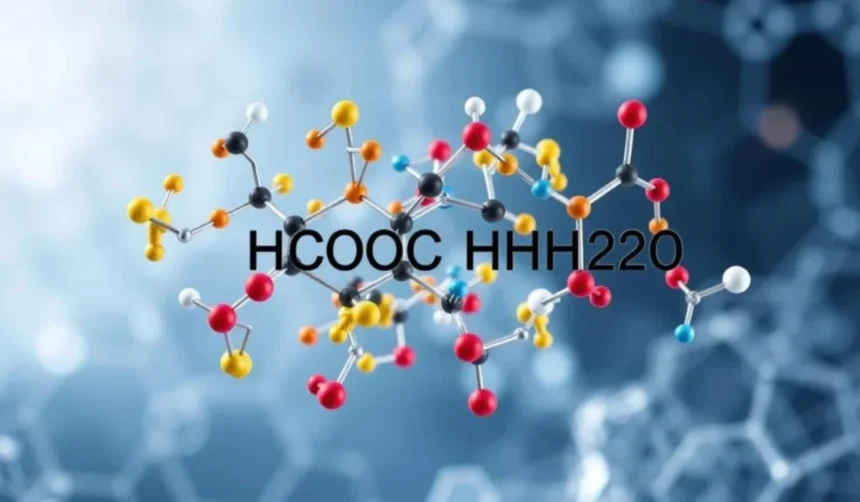In organic chemistry, chemical reactions like hcooch ch2 h2o are common in ester hydrolysis processes. The reaction involves methyl formate (HCOOCH) interacting with water (H₂O), resulting in the breakdown of the ester bond. This produces two distinct products, formic acid (HCOOH) and methanol (CH₃OH). This article delves deeply into the mechanism, products, and significance of this reaction, offering a comprehensive guide to understanding its role in chemistry.
What is the Chemical Structure of HCOOCH?
Before analyzing the reaction, it’s essential to understand the chemical structure and nature of HCOOCH. HCOOCH, also known as methyl formate, is a simple ester derived from formic acid (HCOOH) and methanol (CH₃OH).
Key Characteristics of Methyl Formate (HCOOCH):
- Molecular Formula: C₂H₄O₂.
- Functional Group: Ester (-COO-).
- Physical Properties: A colorless liquid with a slightly fruity odor.
- Applications: Used in organic synthesis, as a solvent, and as an intermediate in the production of formic acid and methanol.
When methyl formate reacts with water, the ester bond (-COO-) is broken through a hydrolysis reaction, leading to the formation of its acid and alcohol components.
What Happens in the HCOOCH CH2 H2O Reaction?
The reaction of hcooch ch2 h2o represents the hydrolysis of methyl formate (HCOOCH) in the presence of water (H₂O). Hydrolysis is a process where a compound reacts with water, splitting into two or more products. In this case, the products are formic acid and methanol.
Reaction Equation:
HCOOCH+H2O⟶HCOOH+CH3OH\text{HCOOCH} + \text{H}_2\text{O} \longrightarrow \text{HCOOH} + \text{CH}_3\text{OH}
Products of the Reaction:
- Formic Acid (HCOOH): A simple carboxylic acid known for its industrial applications and use in leather production.
- Methanol (CH₃OH): A versatile alcohol used in chemical production and as a fuel source.
This hydrolysis reaction is often catalyzed by either acids or bases, depending on the reaction conditions.
Mechanism of the HCOOCH CH2 H2O Reaction
The hydrolysis of esters like methyl formate involves a few key steps. These steps vary slightly depending on whether the reaction occurs under acidic or basic conditions.
Acid-Catalyzed Mechanism:
- Protonation of the Carbonyl Oxygen:
- The ester oxygen is protonated by an acid, increasing the electrophilicity of the carbonyl carbon.
- Nucleophilic Attack by Water:
- Water (H₂O) acts as a nucleophile and attacks the carbonyl carbon, forming a tetrahedral intermediate.
- Cleavage of the Ester Bond:
- The intermediate collapses, breaking the ester bond and forming formic acid (HCOOH) and methanol (CH₃OH).
- Deprotonation:
- Formic acid and methanol stabilize, completing the reaction.
Base-Catalyzed Mechanism:
In basic conditions, the hydroxide ion (OH⁻) acts as the nucleophile, breaking the ester bond and producing the acid salt and alcohol. The acid salt is later converted into formic acid.
Applications of the HCOOCH CH2 H2O Reaction
The hydrolysis of methyl formate has several applications in both industrial and laboratory settings:
- Industrial Production: The reaction is used to synthesize formic acid and methanol, which are critical components in various chemical processes.
- Organic Chemistry: Hydrolysis reactions are fundamental in organic synthesis, serving as a basis for producing carboxylic acids and alcohols.
- Environmental Chemistry: Understanding the breakdown of esters like methyl formate is crucial in environmental monitoring and the study of biodegradable compounds.
Significance of HCOOCH CH2 H2O in Chemistry
The reaction between hcooch ch2 h2o exemplifies a classic hydrolysis process, demonstrating the versatility and reactivity of esters. Esters are widely found in nature, industry, and synthetic compounds, and their hydrolysis is a key step in producing essential acids and alcohols.
This reaction also underscores the importance of reaction conditions, as the outcome can vary depending on whether the process is acid-catalyzed or base-catalyzed.
Conclusion
The reaction of hcooch ch2 h2o highlights the fascinating chemistry of esters and their role in hydrolysis reactions. By breaking the ester bond in methyl formate, this reaction produces formic acid and methanol—two compounds essential to various industries and chemical processes. Whether studied in a lab or applied in large-scale industrial settings, this reaction demonstrates the beauty of organic chemistry’s interconnected processes.
FAQs
What is the product of the HCOOCH CH2 H2O reaction?
The products are formic acid (HCOOH) and methanol (CH₃OH).
What type of reaction is HCOOCH CH2 H2O?
It is a hydrolysis reaction, where an ester (HCOOCH) reacts with water (H₂O) to form an acid and an alcohol.
Does the reaction require a catalyst?
Yes, hydrolysis of esters like HCOOCH often requires either an acid or base catalyst to proceed efficiently.
What are the uses of methyl formate (HCOOCH)?
Methyl formate is used in organic synthesis, as a solvent, and as an intermediate in the production of formic acid and methanol.
Can this reaction occur naturally?
Yes, ester hydrolysis can occur naturally, especially in the presence of enzymes or under certain environmental conditions.
Is this reaction exothermic or endothermic?
The hydrolysis of esters like HCOOCH is generally exothermic, releasing heat during the reaction.


